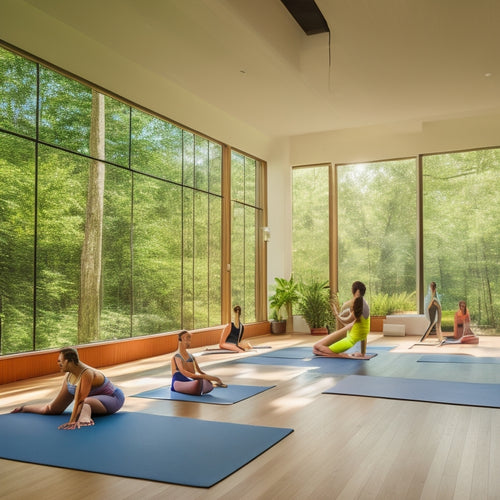
What Exercises Build Core Strength for Belly Dancers?
Share
As a belly dancer, you know that a strong, engaged core is essential for mastering intricate movements and maintaining posture. To build the power, precision, and control you need, focus on exercises that target specific muscle groups, like pelvic floor muscles, transverse abdominis, and core isolations. Practice dynamic exercises like hip circles, arm circles, and core connections to improve technique, posture, and balance. Don't forget to integrate core engagement with breathing techniques and mindful alignment for enhanced control and reduced fatigue. Now, get ready to take your dance to the next level - there's more to discover.
Key Takeaways
• Isolation exercises targeting specific muscle groups, like pelvic floor muscles, enhance core strength and refined technique in belly dance.
• Engaging the transverse abdominis through diaphragm breathing and precise movements improves stability, control, and posture.
• Core connection exercises, such as arm circles, maintain engagement during movements, enhancing technique, posture, and balance.
• Pelvic tilt and bridge exercises strengthen core muscles, improving posture, stability, and control in belly dance movements.
• Focused exercises on scapular stability, shoulder flexibility, and core engagement improve arm circles, balance, and overall core strength.
Engaging Core Muscles Effectively
As you get ready to start a belly dance routine, keep in mind that effectively engaging your core muscles is essential to maintaining good posture, generating power, and preventing injuries. Your core is the foundation of your dance, and proper engagement is vital for a strong, confident performance.
To engage your core, start by focusing on core breathing. Take deep breaths into your diaphragm, feeling your belly expand and contract. This will help you connect with your core muscles and prepare them for movement.
Next, practice muscle wrapping, where you engage your transverse abdominis muscle to support your spine and pelvis. Imagine wrapping a band around your torso, squeezing your abdominal muscles inward and upward. This will help you maintain good posture and generate power for your movements.
Remember to keep your core engaged throughout your routine, especially during dynamic movements like hip circles and shimmies. By focusing on core breathing and muscle wrapping, you'll be able to execute your dance moves with precision, control, and strength.
Building Strength Through Isolation
Building strength through isolation exercises allows you to target specific muscle groups, refining your technique and enhancing overall dance performance.
As a belly dancer, you know that a strong core is essential for precise movements, smooth shifts, and engaging stage presence. Isolation exercises help you achieve muscle segregation, where you engage specific muscles while relaxing others.
This precision is vital for mastering intricate belly dance movements.
Pelvic Floor Muscle Training
You'll tap into the power of your pelvic floor muscles, also known as your 'core canister,' by engaging in targeted exercises that strengthen and tone this essential area. As a belly dancer, you know that a strong core is important for balance, control, and fluid movement. Pelvic floor muscle training is a game-changer for dancers, allowing you to harness your inner power and take your dancing to the next level.
To get started, focus on Kegel exercises, which target the muscles that support your pelvic floor. These exercises will help you develop Pelvic Awareness, a crucial component of belly dancing. By engaging your pelvic floor muscles, you'll improve your overall core strength, stability, and control.
Here are some key exercises to incorporate into your routine:
| Exercise | Description | Benefits |
|---|---|---|
| Kegel Squeeze | Contract and release pelvic floor muscles | Improves bladder control, reduces incontinence |
| Pelvic Tilt | Tilt pelvis upwards and then back down again | Strengthens pelvic floor, improves posture |
| Bridge | Lift hips and lower back, squeezing pelvic floor muscles | Targets glutes and hamstrings, improves overall core strength |
Core Engagement for Balance
By stabilizing your core, you'll establish a solid foundation that allows you to balance and move with precision, setting the stage for more complex and dynamic belly dance movements. As a belly dancer, maintaining proper core alignment is essential for executing intricate movements and preventing injuries.
When your core is engaged, your body posture improves, and you'll find it easier to maintain balance and control.
To engage your core, imagine pulling your belly button towards your spine while keeping your pelvis in a neutral position. This subtle contraction will help you maintain good posture and establish a strong foundation for your movements.
As you practice, focus on maintaining a neutral spine, avoiding arching or rounding your back. By doing so, you'll improve your overall body posture and reduce your risk of injury.
Transverse Abdominis Activation
To activate your transverse abdominis, the deepest abdominal muscle that wraps around your spine and pelvis, imagine drawing your belly button towards your lower back, as if you're zipping up a tight pair of jeans. This subtle yet powerful engagement will become your secret weapon for stability, control, and mesmerizing movements.
As you inhale, focus on diaphragm breathing, allowing your belly to rise and fall with each breath. This will help you connect with your core and quiet your mind.
Here's what you can expect when you master transverse abdominis activation:
- Increased core stability: Your movements will become more precise and controlled, allowing you to execute intricate belly dance movements with confidence.
- Improved posture: Your posture will improve, making you look and feel more powerful and confident.
- Reduced fatigue: By engaging your core, you'll conserve energy and reduce fatigue, allowing you to dance for longer periods without exhaustion.
Dynamic Movements for Core Power
As you start incorporating dynamic movements into your practice, you'll notice a significant boost in your core power.
Now, let's focus on two essential exercises that'll help you develop the strength and control you need: Twisting Torso Rotations and Pivotal Hip Circles.
Twisting Torso Rotations
You'll build powerful core strength and enhance your belly dance movements by incorporating twisting torso rotations into your practice. This dynamic movement targets your obliques, lower back, and abdominal muscles, generating rotational momentum that's essential for belly dance techniques like hip circles and figure-eights.
Twisting torso rotations also improve your spinal flexibility, allowing for a fuller range of motion and more fluid movements. As you practice these rotations, you'll develop the core power needed to execute intricate belly dance patterns with precision and control.
Here are three benefits you can expect from incorporating twisting torso rotations into your practice:
-
Increased core strength: Twisting torso rotations engage your deep abdominal muscles, building the strength and stability you need for more complex belly dance movements.
-
Improved flexibility: Regular practice of twisting torso rotations will increase your spinal flexibility, allowing for a more fluid and expressive dance style.
-
Enhanced rotational momentum: By generating rotational momentum, you'll be able to execute belly dance movements with more power, speed, and control.
Pivotal Hip Circles
By incorporating pivotal hip circles into your practice, you're targeting the deep muscles of your core, generating the power and control needed to execute dynamic belly dance movements with precision and fluidity. This exercise is essential for building a strong foundation, allowing you to move with confidence and control.
As you perform pivotal hip circles, focus on maintaining pelvic awareness, engaging your core muscles to support the movement. Imagine your hips are drawing circles on the floor, first clockwise and then counterclockwise. Keep your upper body still, isolating the movement in your hips. This will help improve your hip flexibility and overall core strength.
Remember to keep your movements slow and controlled, focusing on the sensation of your hips rotating around a fixed axis. This dynamic movement will help you develop the power and control needed to execute intricate belly dance movements with ease.
Integrating Core With Arm Movements
As you integrate your core with arm movements, you'll want to focus on making deliberate connections between your arms and torso.
Start by practicing arm circles, keeping your shoulders relaxed and your elbows soft, while engaging your core to maintain control.
Arm Circles and Control
Mastering arm circles and control requires integrating your core muscles with fluid arm movements, which will enhance your overall belly dance technique and expression. As you move your arms in circular motions, your core muscles work in harmony to maintain posture, balance, and control. This integration is key to executing intricate arm patterns and expressive gestures that captivate your audience.
To achieve flawless arm circles and control, focus on:
-
Scapular stability: Engage your shoulder blades to maintain a strong, stable base for your arm movements.
-
Shoulder flexibility: Increase your range of motion to execute flowing, circular movements with ease.
-
Core engagement: Activate your core muscles to maintain posture, balance, and control as you move your arms.
Core Connection Exercises
Now that you've developed a strong foundation in arm circles and control, you're ready to integrate your core muscles with arm movements through targeted exercises that will elevate your overall belly dance technique.
In this phase, you'll learn to engage your core while moving your arms, creating a powerful connection that will enhance your dance.
Start by standing with mindful alignment, feeling the weight evenly distributed on both feet. Engage your core by drawing your belly button towards your spine. Take a deep breath in, filling your lungs fully, and exhale slowly, allowing your core to relax slightly.
As you inhale, lift your arms overhead, keeping them straight and relaxed. Exhale, and slowly lower them back down, maintaining core engagement. Repeat this sequence several times, focusing on the connection between your core and arm movements.
Remember to practice breathing techniques, inhaling for 4 counts and exhaling for 4 counts, to maintain a steady flow of energy.
As you integrate your core with arm movements, you'll notice improved posture, balance, and overall control in your dance. This powerful connection will take your belly dance to the next level, allowing you to execute intricate movements with precision and confidence.
Core Endurance for Long Routines
You'll be amazed at how boosting your core endurance can transform your ability to power through those lengthy routines with confidence and poise. As a belly dancer, you know that a strong core is essential for maintaining control, precision, and fluidity throughout your performance. However, it's not just about having strong core muscles; it's also about building the endurance to sustain that strength over time.
When you focus on building core endurance, you'll notice significant improvements in your overall performance. Here are just a few benefits you can expect:
-
Reduced muscle fatigue: With improved core endurance, you'll be less prone to muscle fatigue, allowing you to dance with more power and precision throughout your routine.
-
Better breath control: As your core endurance increases, you'll be able to control your breath more efficiently, which is essential for maintaining the intricate movements and rhythms of belly dance.
-
Increased confidence: When you know you can power through a long routine without fatigue, you'll exude confidence and grace, mesmerizing your audience with every step.
Frequently Asked Questions
Can I Practice Core Exercises While Pregnant or Postpartum?
As you navigate the uncharted waters of pregnancy and motherhood, you wonder if core exercises are still on the table. Yes, you can practice, but prioritize prenatal modifications and postnatal rehabilitation to guarantee a safe, empowered journey.
How Often Should I Exercise to See Noticeable Core Strength Results?
To see noticeable core strength results, you'll want to exercise consistently, aiming for 3-4 times a week, as Consistency Matters; schedule conflicts can hinder progress, so prioritize your core workouts to achieve the power you desire.
Can I Still Dance With a Weak Core or Should I Wait?
"Can you still dance with a weak core? Yes, but prioritize building core confidence and dance readiness first, as a strong core enhances performance and reduces injury risk, allowing you to dance with power and precision."
Are There Modifications for Dancers With Back or Neck Injuries?
When managing neck or back injuries, you adapt with gentle alternatives, swapping high-impact moves for low-impact modifications, incorporating injury-friendly props, and prioritizing pain-free postures to protect your precious spine and optimize your belly dance experience.
How Do I Prevent Fatigue and Burnout From Intense Core Workouts?
To prevent fatigue and burnout, you prioritize Active Recovery techniques, like gentle stretching and foam rolling, and practice Mindful Breathing exercises to calm your mind and rejuvenate your body between intense core workouts.
Related Posts
-

Why Lyrical Dancers Need Pro Makeup Guidance Online
As a lyrical dancer, you know that a polished, performance-ready look is essential to showcasing your skills and conv...
-

Essential Spandex Shorts for Yoga and Pilates
Essential spandex shorts are vital for your yoga and Pilates practice. Look for moisture-wicking technology to keep y...
-

Unlock Your Creativity With Dancing Sublimation File
Dancing Sublimation File is a creative catalyst that opens up a world of vibrant design possibilities, providing high...


